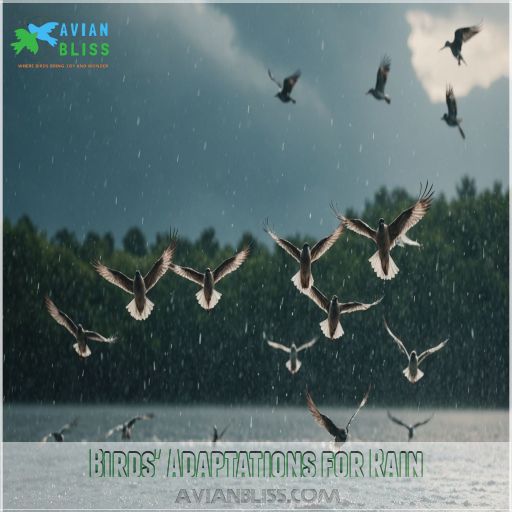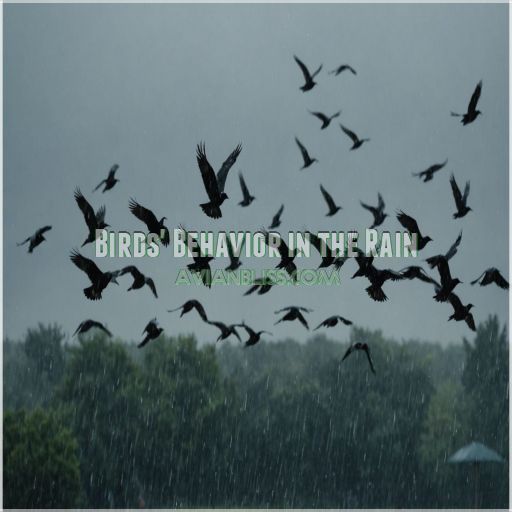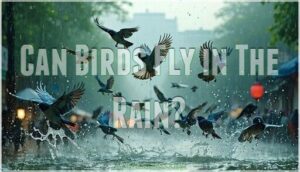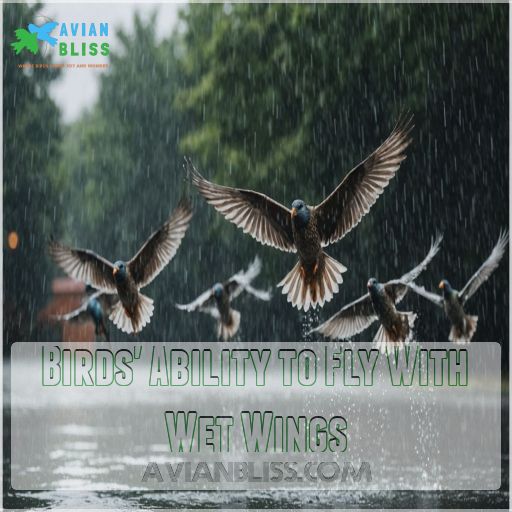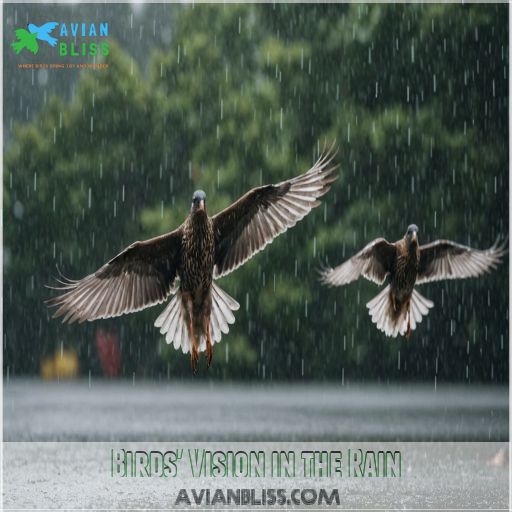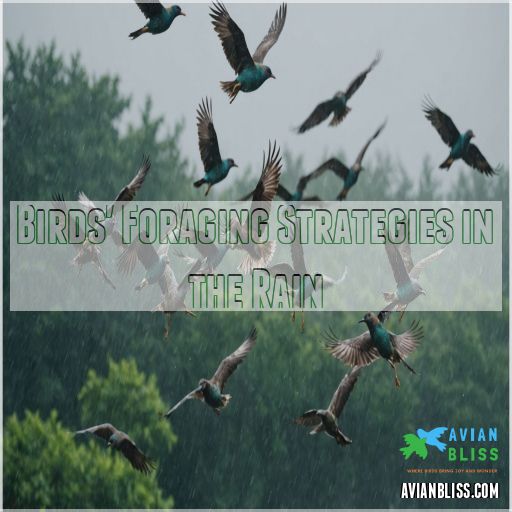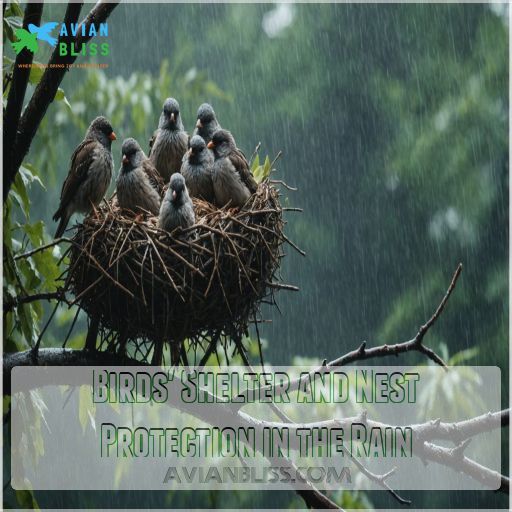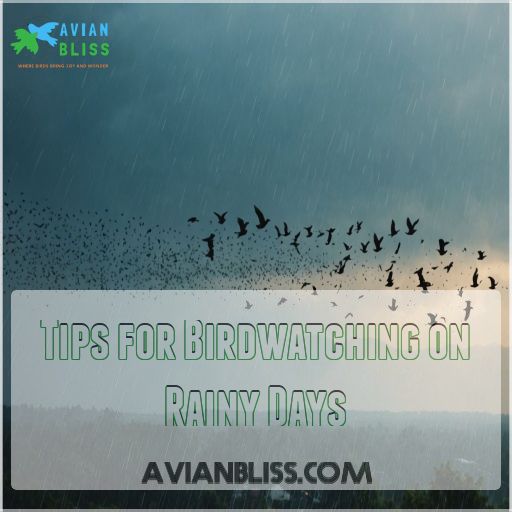This site is supported by our readers. We may earn a commission, at no cost to you, if you purchase through links.
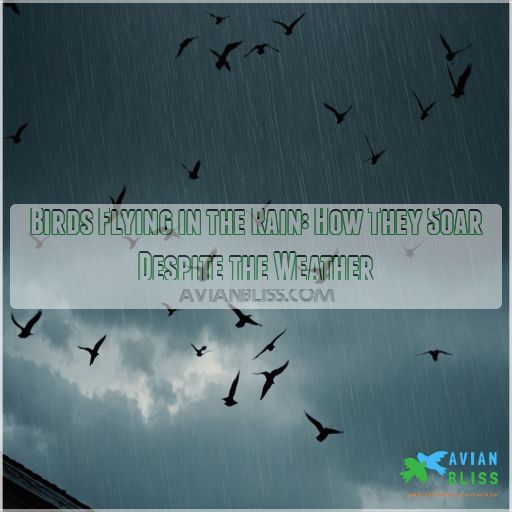
Rain impacts their flight by weighing down their feathers and messing with lift, much like trying to ride a bike with wet clothes.
Thanks to waterproof feathers and nimble wings, some birds can still manage short flights to snag a meal. However, a cozy nook under a tree often looks more appealing.
Curious about how wings manage this damp dance? Stick around for more feathery insights!
Table Of Contents
- Key Takeaways
- Birds’ Adaptations for Rain
- Birds’ Behavior in the Rain
- Can Birds Fly in the Rain?
- Birds’ Ability to Fly With Wet Wings
- Birds’ Rain Tolerance by Species
- Birds’ Vision in the Rain
- Birds’ Foraging Strategies in the Rain
- Birds’ Shelter and Nest Protection in the Rain
- Birds’ Feather Care and Maintenance
- Tips for Birdwatching on Rainy Days
- Frequently Asked Questions (FAQs)
- Can birds still fly in the rain?
- What do birds do in heavy rain?
- Are birds more active in the rain?
- How do birds see when they fly in the rain?
- How does rain affect birds migratory patterns?
- Do birds alter flight altitude during rain?
- Can birds navigation be impacted by rain?
- How do birds find food during heavy rain?
- Are there specific rain-related risks for migratory birds?
- Conclusion
Key Takeaways
- Birds are like nature’s raincoat models, sporting cleverly adapted waterproof feathers and special oil glands to keep them dry. They’re not just gliding gracefully; they’re defying the rain with the style of a feathered superhero!
- When the waterworks start, some birds become air acrobats, adjusting their wing angles and flying low to dodge the worst of the storm. Think of them as nature’s stunt pilots, zigzagging the skies with daring gusto.
- Fancy vision isn’t just for eagles hunting from great heights. Birds have nifty nictitating membranes that act like built-in wipers, so they can see clearly while navigating in the rain. They’re aviators with built-in goggles, cool as a cucumber despite the drizzle.
- Hungry during a downpour? Birds laugh in the face of hunger! With their clever foraging techniques, they feast on rain-brought treats like worms and insects. It’s like the rain turns the ground into a bustling buffet—just without the buffet.
Birds’ Adaptations for Rain
You might wonder how birds manage to stay airborne when it’s pouring cats and dogs.
Well, they’ve got some nifty adaptations up their wings.
From waterproof feathers to membrane-covered eyes, these avian aviators are well-equipped to navigate nature’s watery whims.
Waterproof Feathers and Preen Glands
Birds’ dazzling feather care involves more than just preening for vanity.
Thanks to oil production from their preen glands, these feathery engineers maintain a water-repellent coat.
Their feathers are like nature’s raincoat—remarkably structured to shed water drops as if equipped with magical force fields .
So, next time you’re caught in the rain, channel your inner bird!
Nictitating Membranes for Clear Vision
When rain pours, nictitating membranes act like built-in goggles for birds.
These semi-transparent third eyelids sweep, keeping the eyes moist and debris-free.
Whether soaring or diving, they maintain clear vision, guarding against raindrops like nature’s windshield wipers.
So, next time you’re caught in a drizzle, remember they’ve got more than just feathers for rain adaptation , using their unique features like nature’s windshield wipers.
Wing Shape and Angles for Lift
Your bird’s wings are specially designed to generate lift even in rainy conditions.
The curved shape and precise angles of the wings allow them to efficiently slice through the air, creating an upward force that counteracts gravity (Source).
This aerodynamic prowess helps birds stay aloft despite the added weight and resistance of raindrops.
Oil From Uropygial Glands for Waterproofing
Ever wondered how birds stay dry? The secret’s in the uropygial gland. This special gland produces oil that birds spread while preening, creating a waterproof barrier.
Here’s what they do:
- Preen feathers with oil
- Enhance feather structure
- Maintain waterproofing
- Reduce water absorption
- Stay warm and buoyant
Nature’s own raincoat!
Birds’ Behavior in the Rain
When it rains, birds don’t just shrug and carry on; they get creative with their survival tactics.
They employ various strategies to cope with the rain, including seeking shelter, minimizing water exposure, and adjusting their flight strategies.
Like tiny feathery superheroes, they dodge raindrops with ease, showcasing their incredible adaptability and resourcefulness as tiny feathery superheroes.
Seeking Shelter and Minimizing Water Exposure
Birds aren’t daunted by a little rain.
Finding shelter plays a big role in avoiding rain-induced hypothermia. Some might prefer cozy spots under dense shrubs or lean against tree trunks to minimize water exposure .
Feather care is essential, as waterlogging effects can chill them quickly. With their feathers sleeked, birds cleverly navigate these soggy challenges, balancing warmth and dryness .
Adjusting Flight Strategies to Avoid Rain
When rain-induced turbulence hits, some birds make wing angle adjustments and fly close to the ground, cleverly dodging the storm like nature’s stunt pilots.
With zigzag flight patterns and airflow manipulation akin to acrobatic aerodynamics, these feathered marvels remind us of daring trapeze artists, adapting to the skies’ whimsical challenges with finesse and a sprinkle of avian audacity .
Foraging for Food in Rainy Conditions
So you’ve noticed birds cleverly finding food despite the deluge.
These little warriors persist! Picture them seeking out worms emerging in rain, spotting increased insect activity, or snacking on rain-soaked seeds.
Their foraging adaptations amaze: smaller birds, despite food scarcity, adapt with agile moves.
Rain or shine, they’ve got it covered—no umbrella necessary!
Just winging it with style.
Increased Activity After the Rain
With the rain gone, it’s like nature hit refresh. Birds jump into insect abundance, their songs ringing through the damp air.
Worms surface, making foraging a breeze. It’s a busy, bustling world out there where feather preening becomes a priority, like a bird’s spa day.
Nest building picks up, too—after all, who wants a soggy home?
Can Birds Fly in the Rain?
Can birds really take flight in the rain?
As it turns out, many avian species are remarkably well-equipped to soar through the wettest weather.
From waterproof feathers to specialized wing shapes, birds have evolved ingenious adaptations that allow them to brave the elements and keep on flying with ingenious adaptations.
Factors Affecting Flight in Rainy Conditions
Rain can make bird flight a bit like flying through molasses.
You might picture:
- Air pressure changes affecting flight altitude.
- Wing loading adjustments needed for stability.
- Wind resistance impacting speed and direction.
- Feather condition influencing aerodynamics.
Each factor plays a part in how well our feathered friends navigate rainy skies .
Weight of Water on Feathers and Flight
Imagine yourself carrying a drenched coat while running; that’s akin to what birds face when rain-soaked feathers increase their weight.
This added weight from water affects flight efficiency, challenging their aerodynamics.
However, clever adaptations, like waterproof feathers from their preen glands, offer a helping wing to maintain buoyancy during flight, keeping birds soaring even in the rain .
Effects of Rain on Wing Movement and Lift
When it rains, birds face new challenges. Extra wing weight from water can mess with their usual feather angle and lift generation.
Rain impact increases air resistance, making flying a tricky business. Picture raindrops as tiny weights, pulling wings down.
Yet, some birds defy nature’s whims, demonstrating an innate resilience, even when the skies are doing their best to keep them grounded, showing their ability to handle tricky business.
Birds’ Ability to Adapt to Rainy Conditions
Birds are masters of adaptation, even in rainstorms. They tweak their flight to minimize rain-induced feather damage and embrace water-resistant feathers and oils.
They alter their behavior to adapt to the rain in various ways, including:
- Flight angles and wing shape
- Rain-related foraging behavior
- Bird migration patterns in wet climates
- Adaptations for wet feathers
- Nesting strategies to protect vulnerable nestlings
They mightn’t love the rain, but they thrive.
Birds’ Ability to Fly With Wet Wings
When rain soaks a bird’s wings, flight becomes a slippery dance that tests their aerial agility.
You’ll be amazed at how some birds handle it with ease, while others struggle like a person trying to run in flip-flops.
Challenges of Flying With Wet Feathers
Battling the elements, wet feathers increase feather weight and air resistance, reducing flight efficiency and upping energy expenditure. Picture yourself jogging in a soaked sweater! Instead of soaring gracefully, birds struggle as if wearing lead boots.
| Factor | Impact | Result |
|---|---|---|
| Feather Weight | Increased | Reduced lift |
| Wing Loading | Higher | More energy needed |
| Air Resistance | Increased | Slower flight speed |
Feeling for our feathered friends yet?
Effects of Water on Wing Movement and Lift
So, you’ve seen birds shake off rain like they’ve got a magic trick up their feathers!
But no spell’s involved—wet wings mean heavier feather weight, greater wing drag, and less lift due to reduced air resistance.
It’s like trying to fly with a soaked backpack!
And despite water buoyancy, rain can still cramp their feathered style.
Birds’ Adaptations to Overcome Wet Wing Challenges
Rain may soak the skies, but some birds tackle wet wings with flair.
Imagine having a raincoat like their waterproof feathers! Thanks to the preen gland, birds apply oil for staying dry.
Wing adjustments play a part too, turning tricky winds into a flight partner.
With nictitating membranes, vision’s not a washout. Talk about a feathered superpower! .
Which Birds Can Fly With Wet Wings?
When it pours, certain birds like ducks and turkey vultures can fly even with wet wings, thanks to their robust wing shape and feather types.
These adaptations help maintain flight mechanics despite reduced lift from rain intensity.
Larger bird size aids stability, with waterproof feathers forming a natural raincoat .
Flying in the rain? Piece of cake!
Birds’ Rain Tolerance by Species
In the fascinating world of avian adaptation, species differ greatly in their ability to handle rainy weather.
You’ll find some birds zipping about even in downpours, while others prefer to keep their feathers dry and cozy.
Birds That Can Fly in Heavy Rain
Just as some athletes thrill in challenging weather, certain birds ace flying in heavy rain. They’re like nature’s daredevils with rain-resistant feathers and specialized wings.
Check out these top flyers:
- Ducks—playful even in storms
- Turkey vultures—heat-seekers who may rain-bathe
- Seabirds—masters of stormy skies .
Ready to explore more?
Birds That Avoid Flying in Rain
While some birds brave heavy rain, others hunker down, especially smaller ones.
They face challenges like less dense air, which messes with their flight lift, leading them to seek shelter.
Imagine a tiny bird using a tree as an umbrella—smart move! These rain-avoiding birds conserve energy and warmth, waiting for the storm to pass .
Birds That Are Well-Adapted for Rainy Conditions
Certain birds, like ducks and geese, are well-equipped to handle rainy conditions.
Their waterproof feathers, oil-producing preen glands, and streamlined wing shapes allow them to:
- Repel water and maintain insulation
- Adjust their flight to maximize lift and stability
- Forage and hunt effectively even in heavy downpours
These adaptations enable rain-tolerant species to thrive in wet weather, unfazed by the challenges that can ground less prepared birds.
Birds That Struggle in Rainy Conditions
Now, let’s chat about the birds that aren’t exactly cut out for rainy conditions. Owls and raptors, for instance, have feathers that soak up water like a sponge, dragging down their flight efficiency and adding rain-induced stress.
Picture a drenched-to-the-bone honeycreeper battling food scarcity and struggling to fly.
| Bird Type | Rain Challenge | Adaptation Needed |
|---|---|---|
| Owls | Feather soak | Better waterproofing |
| Raptors | Flight efficiency | Enhanced feather drying |
| Honeycreepers | Rain-induced stress | Improved shelter-seeking |
| Snipe | Nest flooding | Relocation strategies |
These birds need a little extra rain prep!
Birds’ Vision in the Rain
Rain can make a bird’s vision as blurry as your glasses in a downpour, but birds have some neat tricks up their feathers to see clearly.
You’ll be surprised how they manage to dodge raindrops and navigate with precision!
Effects of Rain on Birds’ Vision
Rain transforms into an optical challenge for birds—droplets can blur vision, much like a smudged windshield.
Yet, they’re neither hindered nor daunted. Birds cleverly navigate by relying on their keen senses and using their special, translucent eyelids, which offer a clear view despite the downpour .
It’s like having built-in wipers for their eyes, ensuring nothing gets lost in translation. Birds have adapted to navigate effectively in the rain, allowing them to continue their normal activities without any issues, thanks to their special, translucent eyelids.
Adaptations for Improved Vision in Rain
When skies pour, birds employ nifty adaptations to keep their vision sharp.
Thanks to the nictitating membrane, a translucent third eyelid, they maintain vision clarity and shield their eyes from moisture.
Additionally, rain-adapted vision and water-repellent feathers help them spot dangers and opportunities from above, making them feel like superheroes every time it rains .
How Birds Navigate in Rainy Conditions
In stormy weather, birds navigate using keen vision and clever flight strategies.
Their nictitating membranes shield eyes from rain, while air pressure changes guide them.
Adjusting wings to manage rain-induced turbulence, they soar like seasoned pilots. Picture a jetliner slicing through clouds—birds, too, adapt, maintaining course even during challenging conditions, showcasing resilience nature has gifted them, with clever flight strategies .
Birds’ Foraging Strategies in the Rain
Rain might send you scurrying for cover, but for birds, it can mean a buffet line opens up.
With worms wiggling to the surface and insects abuzz after a shower, birds have clever strategies to fill their bellies even when skies aren’t clear, and this is particularly evident on days when it rains.
Increased Availability of Food After Rain
After a good rain, the ground comes alive with worms emerging , insects buzzing , and seeds sprouting . Savvy birds recognize these cues, adjusting their foraging patterns to capitalize on the bounty.
- Increased prey availability
- Easier access to buried food sources
- Stimulated plant growth for seed-eaters
- Concentrated food sources in wet areas
Birds’ Adaptations for Foraging in Rain
Rain brings a surge of food opportunities, like rain-soaked seeds and wriggling worms.
Birds’ adaptations make them masters at foraging despite the weather. Sharp beaks and keen eyesight help them locate elusive snacks, even while raindrops drum around.
Their waterproof feathers keep them cozy and dry, proving that, indeed, every cloud has a silver lining for our feathered friends .
Changes in Foraging Behavior During Rain
When the heavens pour, think of birds as savvy diners finding food at a buffet.
Their foraging behavior shifts to brave the rain:
- Smaller birds may head for shelter to keep dry and save energy .
- Parrots adjust to barometric changes, prepping for reduced food access .
- Ibis exploit wet conditions for easier worm and insect snacks .
Birds’ Ability to Find Food in Rainy Conditions
Imagine you’re a bird in a rainstorm, finding your way through your drenched world.
Thankfully, rain-soaked insects offer a feast, and worms are more available.
Your shelter choices impact your foraging efficiency, and adaptations help you thrive despite the downpour.
Some clever bird species even stash food beforehand, so think of rain as nature’s buffet, albeit with a soggy twist .
Birds’ Shelter and Nest Protection in the Rain
When it’s raining cats and dogs, birds aren’t just winging it; they’ve got shelters and strategies to keep dry and safe.
Whether they’re huddling under leafy branches or reinforcing nests, birds have some nifty ways to weather the storm and keep their homes protected.
Birds’ Shelter Options in Rainy Conditions
Spot a rainy day? Birds instinctively seek shelter, using tree canopies, urban porches, and well-placed birdhouses for cover.
Imagine them nestled under leafy umbrellas, appreciating your thoughtful birdhouse design.
Birds choose rain-proof nests, tailoring their shelter preferences to the terrain. The tree canopy impact offers natural protection, while urban shelter options provide a handy refuge when skies release their watery wrath.
The birds’ preference for shelter is also influenced by the surroundings, as they choose rain-proof nests that suit their needs.
Protecting Nests From Rain and Water
Some birds are true architects when it comes to nest protection from rain. They use natural materials and clever placements to secure shelter.
- Nest Materials: Birds often incorporate water-resistant elements like leaves and moss.
- Rainwater Runoff: Nest placement facilitates drainage.
- Shelter Design: Strategic site selection, such as under dense foliage, provides insulation .
Birds’ Adaptations for Nest Protection
Birds have evolved ingenious ways to shield their nests from the elements.
Some species use water-repellent materials like mud, leaves, and twigs to create rain-resistant structures .
Others strategically position their nests in sheltered spots, like tree cavities or under overhanging branches, to keep their eggs and hatchlings dry .
These adaptations help birds protect their vulnerable offspring during stormy weather.
Importance of Shelter for Birds in Rain
Imagine rain as a challenge course for birds seeking freedom in the skies.
To keep warm and dry, they need shelter—a life raft in a sea of stormy weather.
Dense bushes, trees, and even nifty hideouts like nesting boxes provide essential protection.
Without these shelters, birds could face hypothermia, as moisture quickly steals their warmth .
Birds’ Feather Care and Maintenance
In soggy weather, birds become their own feather stylists, slathering on waterproofing oils like avian hair gel.
This feather care routine is essential, as it prevents them from turning into drenched, flightless puffballs when the skies open up.
Importance of Waterproofing Feathers
Splashing through a sudden downpour, you might envy birds’ waterproof feathers. Their secret? A slick of oils from the preen gland, making rain bead off like magic .
This natural armor’s important for feather care and maintenance, ensuring flight and warmth.
Think of it as nature’s raincoat, keeping them agile and free even in wet weather.
Methods for Maintaining Waterproof Feathers
To keep feathers waterproof amidst nature’s whims, birds rely on the savvy employment of preen glands, carefully distributing oils to make sure water-shedding perfection. Curious how they do it?
- Daily Preening: Aligns feather barbules, sealing gaps.
- Feather Oil Application: Maintains water resistance.
- Social Grooming: Birds often preen each other, enhancing friendship and water defense .
Effects of Rain on Feather Condition
So, you’ve figured out waterproofing, but rain still tests feathers’ limits. Feather damage occurs when water absorption outpaces an oil gland’s protective layer, leading to wear and heat loss.
Birds manage through:
| Challenge | Solution |
|---|---|
| Water absorption | Oils from glands |
| Feather wear | Frequent preening |
| Heat loss | Feather fluffing |
| Body chill | Sheltering |
Birds’ Adaptations for Feather Maintenance
You ever wonder how birds maintain their feathers in rain?
They preen like pro hairstylists, using oil from glands near their tails to waterproof their feathers.
Some birds also have special feathers called powderdowns—these disintegrate into a protective powder.
This routine keeps their feather structure intact, ensuring they stay dry and ready to soar—even when the sky’s pouring .
Tips for Birdwatching on Rainy Days
Don’t let a little rain dampen your birdwatching adventures!
With the right tips and precautions, you can still spot feathered friends even on a drizzly day.
From choosing the best locations to identifying birds in the rain, we’ve got you covered to make the most of your rainy day birdwatching experience.
Best Locations for Birdwatching in Rain
When the skies open up, urban parks and forest edges become birdwatching havens.
Migrants rest in rain-resistant habitats, creating unexpected spectacles.
Coastal spots are golden too—imagine raptors riding winds like surfers!
Join fellow birders in trusty shelters, where rain is just another part of the show.
Embrace the weather and discover nature’s secret, rainy-day performances! .
Tips for Spotting Birds in Rainy Conditions
Rainy birdwatching reveals a secret world.
Focus on rain-adapted birds, like ducks and herons, often unfazed by rain-soaked plumage.
For spotting techniques, seek high canopies or open water. Use binoculars with rain guards, and wear layers to stay dry.
Sometimes, the best bird shelter types are leafy trees offering cover, letting you embrace nature’s dance with drizzle .
How to Identify Birds in the Rain
Spotting birds in rain can seem tricky, but rain-soaked plumage gives clues.
Listen for bird calls that reveal rain behavior and shelter choices. Silhouettes against gray skies help in identifying species.
Birds hunker down, conserving energy—like little feathered umbrellas! So, grab those binoculars and admire their resilience, even as droplets dance around them, showcasing their little feathered umbrellas .
Safety Precautions for Birdwatching in Rain
While birdwatching on rainy days, stay safe and comfortable. Grab your rain gear and a weather app for updates.
Remember these safety tips:
- Visibility Matters: Use bright raincoats to stay visible.
- Understand Bird Behavior: Birds might seek shelter.
- Watch Your Step: Trails can be slippery.
- Tools Ready: Keep binoculars dry for clear views.
Enjoy the birds’ rainy day antics!
Frequently Asked Questions (FAQs)
Can birds still fly in the rain?
Yes, birds can fly in the rain, but it’s not their favorite pastime.
Low air pressure makes flying tougher, so they often perch and conserve energy.
However, if hunger strikes, they’ll brave the rain for food (Source).
What do birds do in heavy rain?
Imagine rain as nature’s confetti.
In heavy rain, birds often sleek down their feathers or seek shelter to stay warm and dry.
Small birds might hide, while larger ones sometimes enjoy the rain .
Are birds more active in the rain?
In rainy weather, birds aren’t typically more active.
They often seek shelter to conserve energy and maintain warmth.
However, waterfowl may frolic happily in the rain, enjoying the wet conditions as part of their natural habitat .
How do birds see when they fly in the rain?
Birds rely on their nictitating membrane, a third eyelid acting like a rain shield, allowing them to see in the rain.
By sweeping moisture away and protecting their eyes while flying, this membrane provides the necessary protection.
How does rain affect birds migratory patterns?
When it rains, it’s par for the course that birds hunker down, halting migratory flights.
Heavy rain can lead to delays as birds seek shelter from the deluge, affecting their energy reserves and timing .
Do birds alter flight altitude during rain?
During rain, birds often fly lower or avoid flying altogether because low atmospheric pressure makes the air less dense, requiring more energy for flight.
They conserve energy by perching and waiting for better conditions . This is done as a result of the low atmospheric pressure making the air less dense, which requires more energy for flight.
Can birds navigation be impacted by rain?
Ah, the rain – nature’s symphony that can throw a wrench in a bird’s navigation plans.
But fear not, feathered friends, for your keen senses can still guide you through the downpour.
How do birds find food during heavy rain?
Birds, in their clever way, adapt to heavy rain by seeking shelter and reducing movement.
While some waterbirds thrive by exploiting newly accessible food sources in flooded areas, showcasing nature’s resilience .
Are there specific rain-related risks for migratory birds?
Migratory birds face rain-related risks like disorientation and exhaustion due to difficult flying conditions and decreased visibility.
These challenges can lead to potential collision with structures or predators.
They also cause challenges in finding food and safe resting spots .
Conclusion
Picture birds as the original storm dancers, twirling through raindrops with grace.
Despite the challenges posed by wet weather, their adaptations—waterproof feathers, fine-tuned wings, and instinctive behaviors—allow them to navigate rainy skies effectively.
As you observe birds flying in the rain, appreciate their resilience and ingenuity.
Whether gliding through a drizzle or opting for shelter, birds demonstrate remarkable adaptability.
Next time it rains, grab your umbrella and watch nature’s feathery performers take the stage.

